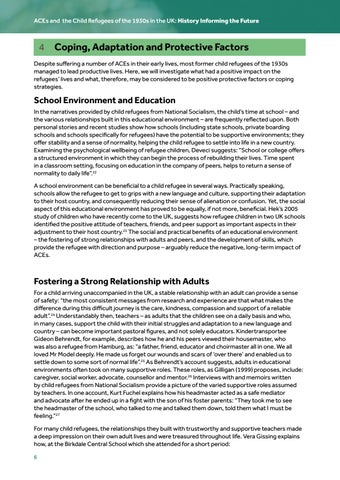ACEs and the Child Refugees of the 1930s in the UK: History Informing the Future
4 Coping, Adaptation and Protective Factors Despite suffering a number of ACEs in their early lives, most former child refugees of the 1930s managed to lead productive lives. Here, we will investigate what had a positive impact on the refugees’ lives and what, therefore, may be considered to be positive protective factors or coping strategies.
School Environment and Education
In the narratives provided by child refugees from National Socialism, the child’s time at school – and the various relationships built in this educational environment – are frequently reflected upon. Both personal stories and recent studies show how schools (including state schools, private boarding schools and schools specifically for refugees) have the potential to be supportive environments; they offer stability and a sense of normality, helping the child refugee to settle into life in a new country. Examining the psychological wellbeing of refugee children, Deveci suggests: “School or college offers a structured environment in which they can begin the process of rebuilding their lives. Time spent in a classroom setting, focusing on education in the company of peers, helps to return a sense of normality to daily life”.22 A school environment can be beneficial to a child refugee in several ways. Practically speaking, schools allow the refugee to get to grips with a new language and culture, supporting their adaptation to their host country, and consequently reducing their sense of alienation or confusion. Yet, the social aspect of this educational environment has proved to be equally, if not more, beneficial. Hek’s 2005 study of children who have recently come to the UK, suggests how refugee children in two UK schools identified the positive attitude of teachers, friends, and peer support as important aspects in their adjustment to their host country.23 The social and practical benefits of an educational environment – the fostering of strong relationships with adults and peers, and the development of skills, which provide the refugee with direction and purpose – arguably reduce the negative, long-term impact of ACEs.
Fostering a Strong Relationship with Adults
For a child arriving unaccompanied in the UK, a stable relationship with an adult can provide a sense of safety: “the most consistent messages from research and experience are that what makes the difference during this difficult journey is the care, kindness, compassion and support of a reliable adult”.24 Understandably then, teachers – as adults that the children see on a daily basis and who, in many cases, support the child with their initial struggles and adaptation to a new language and country – can become important pastoral figures, and not solely educators. Kindertransportee Gideon Behrendt, for example, describes how he and his peers viewed their housemaster, who was also a refugee from Hamburg, as: “a father, friend, educator and choirmaster all in one. We all loved Mr Model deeply. He made us forget our wounds and scars of ‘over there’ and enabled us to settle down to some sort of normal life”.25 As Behrendt’s account suggests, adults in educational environments often took on many supportive roles. These roles, as Gilligan (1999) proposes, include: caregiver, social worker, advocate, counsellor and mentor.26 Interviews with and memoirs written by child refugees from National Socialism provide a picture of the varied supportive roles assumed by teachers. In one account, Kurt Fuchel explains how his headmaster acted as a safe mediator and advocate after he ended up in a fight with the son of his foster parents: “They took me to see the headmaster of the school, who talked to me and talked them down, told them what I must be feeling.”27 For many child refugees, the relationships they built with trustworthy and supportive teachers made a deep impression on their own adult lives and were treasured throughout life. Vera Gissing explains how, at the Birkdale Central School which she attended for a short period: 6


